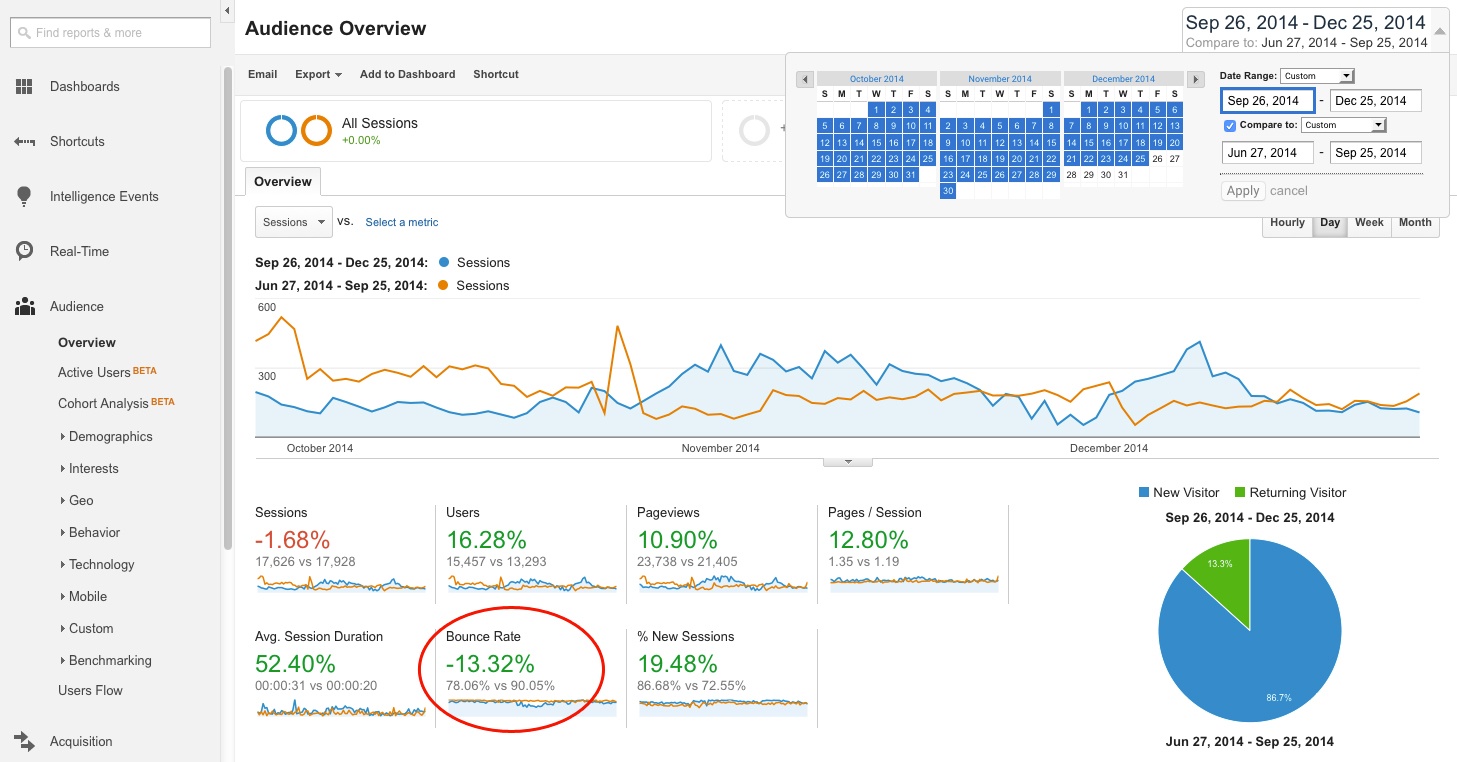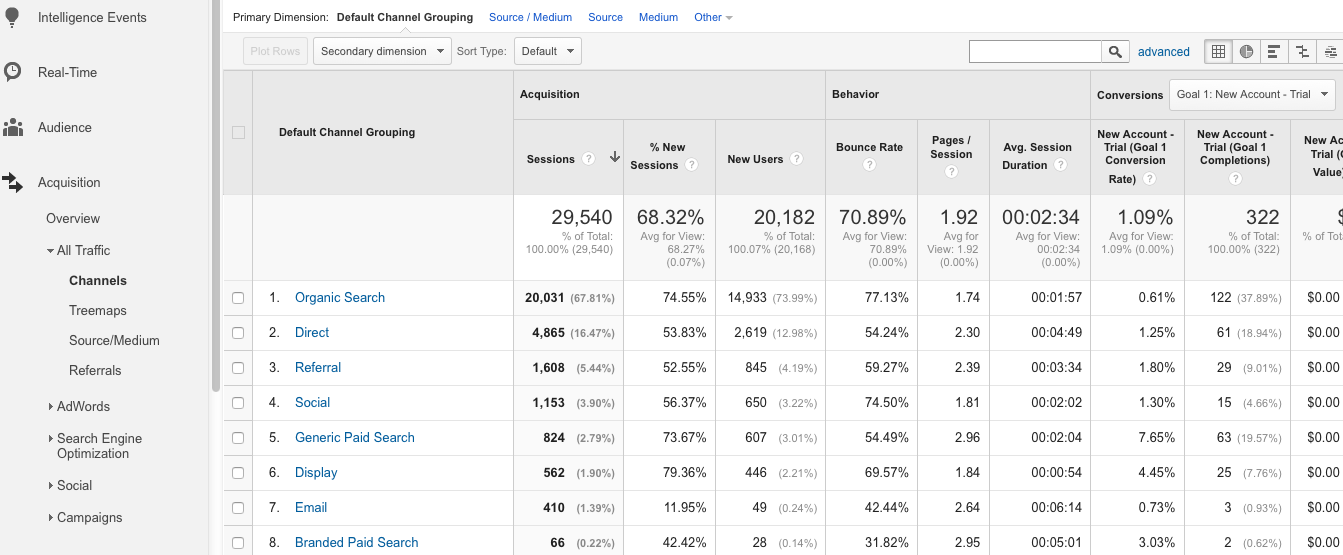- How important is bounce rate in assessing website performance?
- What’s a good bounce rate?
- How does bounce rate work together with other metrics?

What Can Bounce Rate Tell You about Your Visitors?
- Is your content engaging: are people leaving after reading just one page, with no interest in looking at other pages?
- How well is your conversion funnel working: are people dropping off before requesting more information or downloading a resource?
- Where are people encountering difficulty navigating your site: are they bouncing from specific pages because they’re confused about how to find what they’re looking for or the answer to their problem?
What is a Good Bounce Rate?
Ultimately, this is what everyone wants to know. While many people may throw out ranges of “good” bounce rates (for example, saying > 70% is problematic, and < 40% is decent), there is no clear-cut answer to this question. Answers can vary widely depending on the type of site.
Too often, online marketers point to bounce rate as an end-all stat determining whether or not a site is working. However, making decisions based on bounce rate, or any metric, by itself doesn’t take into account the full picture of website performance.
For instance, a Bounce Rate of 90% on an e-commerce site with hundreds of products likely indicates a problem with engagement. People are not taking the time to browse through products or to complete a purchase.
However, the same Bounce Rate of 90% on a one-page lead generation landing page, which offers users no other choice beyond filling out a form, may actually be a positive metric. In this case, the 10% of people who aren’t bouncing are likely submitting the form and showing further interest in the business. We don't really know what the other 90% are doing. They may have submitted the form and moved on without having any further interaction until receiving another call to action from your business (an email offer, a call to discuss their needs, etc). Or they may not have converted at all. This, of course, requires a greater view of your conversion numbers to see if your customers are acting and bouncing, or just bouncing without any conversion. Clearly, what entails a “good” bounce rate varies among different industries and different styles of websites.
Ultimately, you should take into account bounce rate alongside other metrics on your site. For instance, a high bounce rate along with a high conversion rate may simply reflect the nature of your site’s design (as in the landing page example).
In addition, watch for trends over time. If your bounce rate is increasing, that may signify a red flag that more people are encountering a poor experience on your site. If it’s decreasing, your site is likely showing improved engagement.
Although you can find (often over-generalized) “industry standard” data, your own data always tells the best story of how your brand should be performing. Once your site has been active for a certain timeframe (six months, one year, etc), you can flag changes in metrics to identify both reason for concern and signs of improvement. High bounce rate can indicate that people don’t understand your content or that they’re having trouble getting through the intended path on your site.
For instance, a site built to generate public awareness for a cause showcased a video front and center on the homepage. The purpose of the video was to educate visitors on how to safely dispose of medication in their own home. Getting visitors to watch the video was one of the key goals of the campaign. However, analytics showed that only a small percentage of visitors were actually hitting play. To address this, the web team revised the site to include an animated video preview that played in the background with a larger play button. A click to play the video was, in turn, tracked as an Event in Google Analytics (thus counting as an interaction so a Session wouldn’t count as having bounced).
Looking at data from three months after the change compared to three months before, we see clear improvement in engagement on the site as a whole. Bounce Rate, while still relatively high, decreased from above 90% to below 80%.
In addition, other metrics here show improvement, such as a 52% increase in Avg. Session Duration (indicating more time spent on the site). As brought up previously, you should look at multiple metrics together to assess changes in website performance.
Be sure to look at a long enough timeframe to ensure results are statistically significant. Here, we’ve shown a three-month window of time on either side of the website changes, as opposed to simply showing one week before and after, which wouldn’t be enough time for an accurate picture of improvement.
Considering Bounce Rate for Content Pieces
Bounce rate can have some flaws in representing engagement, as well. By default, a “bounce” will occur when someone doesn’t click to visit another page. This can still occur even if that person spends ten minutes thoroughly reading a blog article but decides not to ready any other articles. In that case, the person still spent time engaging with content on the site, so it’s not accurate to interpret the “bounce” as meaning the person left right away.
To establish a more accurate picture of bounce rate on content pieces, see our article on How to Track Content Engagement in Google Analytics. Using the technique described here, you’ll send Events to Google Analytics when users take the time to scroll into an article, eliminating bounces from those who are at least reading beyond the “fold.” That way, bounce rate more accurately represents those who didn’t choose to interact with the site.
Using Bounce Rate to Assess Marketing Channels
Bounce rate can also provide a window into the performance of online marketing efforts. You can determine what sources are most likely to drive engaged visitors.
However, you should also be careful not to use bounce rate as the end-all determiner for channel success. For instance, visits from display advertising often show a higher bounce rate than visits from search. People searching for your services are much more likely to be pre-qualified individuals ready to buy than people initially discovering you from a display ad. You may still find that display converts long-term, however, or helps in driving brand awareness.
For instance, see here how Display shows a higher Bounce Rate than other channels, but also shows one of the highest Conversion Rates.
Conclusion
Bounce rate is an important metric for indicating problems with engagement and conversion on your site, as well as showing improvement or decline after edits when looking at data over time. However, you must also take into account other metrics on your site alongside bounce rate in assessing success. Ultimately, this is just one of many metrics that help you determine how well a website is delivering on business goals.



